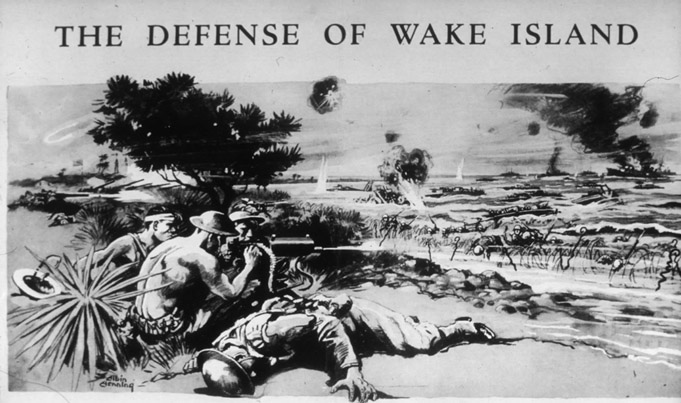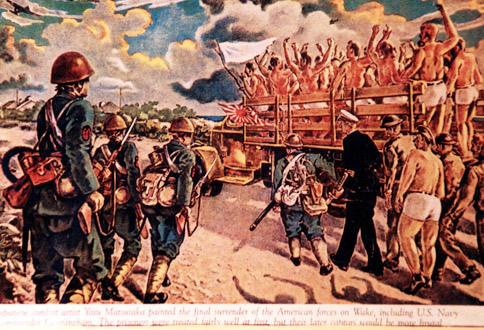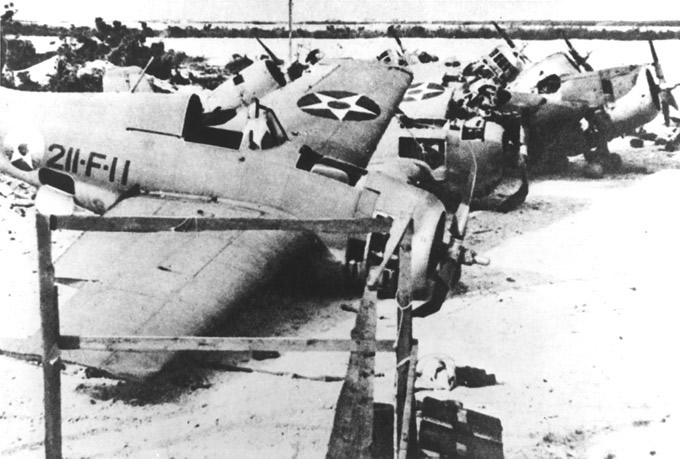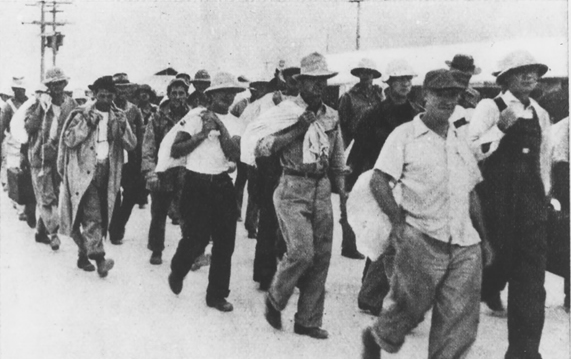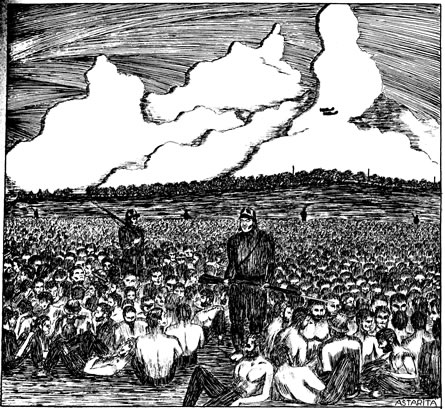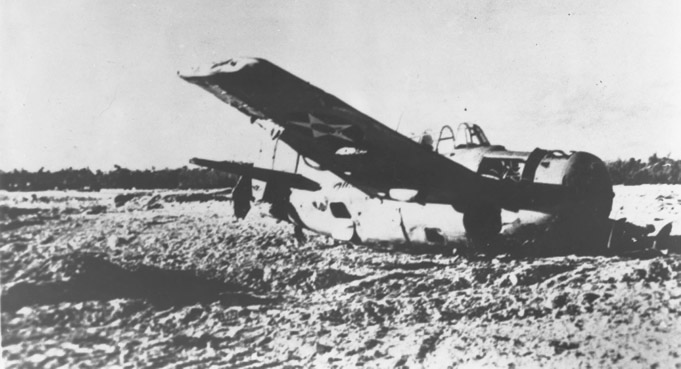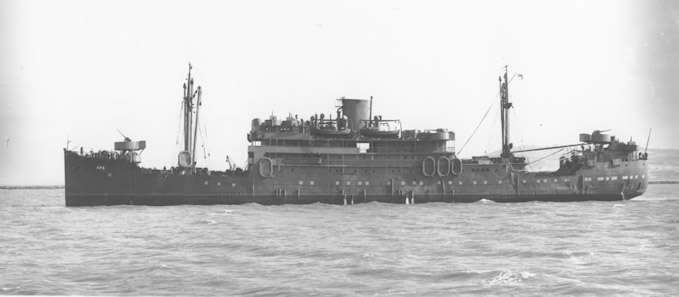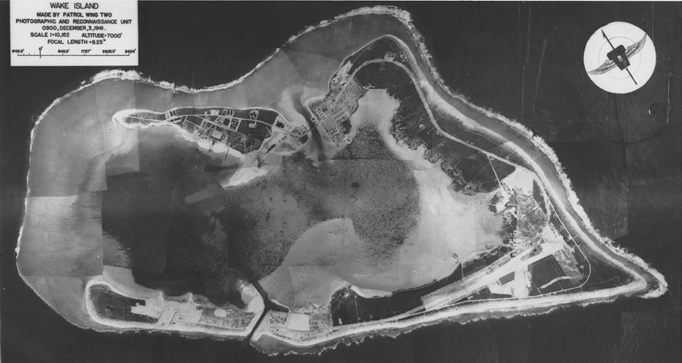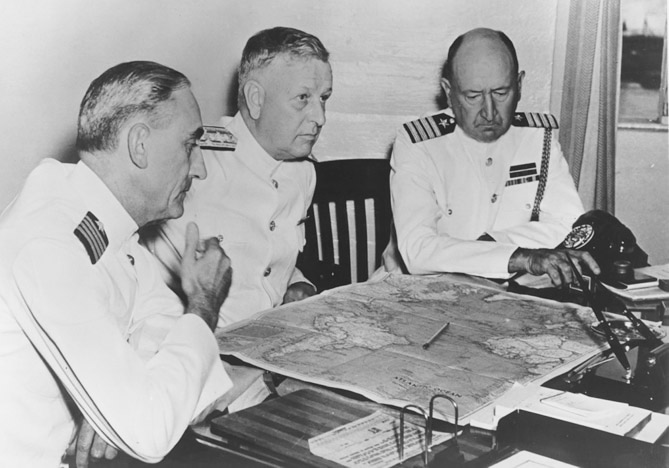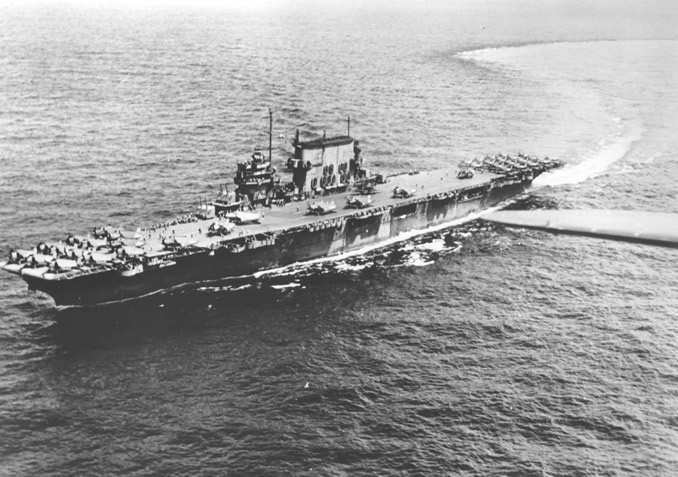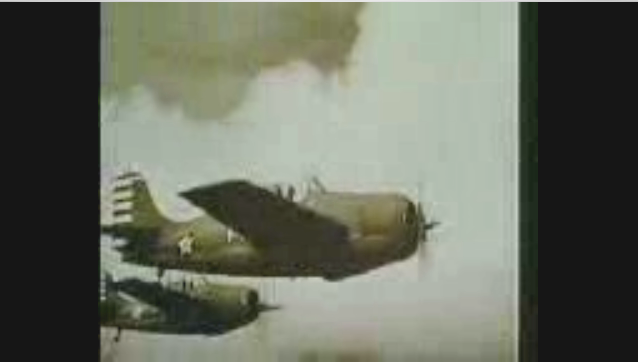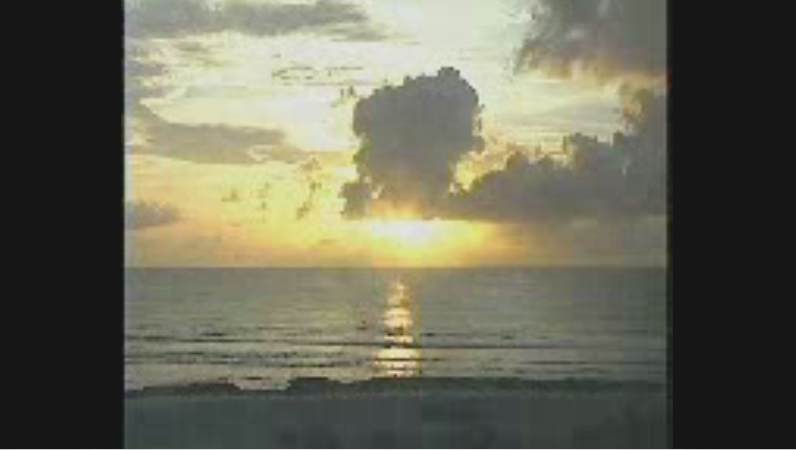Before There Were SeaBees There Were...
THOSE WHO ALSO SERVED
The Civilian Construction Men of Wake Island
These are the men that history almost forgot.
In 1941, more than 1,100 civilian men ventured 4,000 miles across the Pacific to desolate Wake Island to build a U.S. Navy base. Just hours after Pearl Harbor was bombed, Wake Island was attacked and these men were thrust into the forefront of the war in the Pacific.
Few know the story of the un-enlisted -- the civilians -- who originally went to Wake Island to help build a naval base and ended up fighting and dying for their country.
Indeed it wasn’t until 1981 that the U.S. government officially recognized those civilians who had served heroically on Wake as “veterans” of World War II.
Of the 1,100 civilians, who originally went to Wake Island to build the Navy base, many lost their lives in the initial combat for the Island. After the island fell, the survivors were shipped off to P.O.W. camps in China and Japan to wait out the rest of the war. 98 civilians were retained on the island to serve the needs of the Japanese military. Their time on the island would end in dire consequences.
“Those Who Also Served” is the story of the men who went to Wake Island to earn good wages so they could go to college or those looking for travel and adventure far from their depression era existence in Middle America. It was those who -- without even the basics of military training -- took up arms against the enemy when attacked.
Who might wish to own a copy of this documentary account of the civilian contractors and their service on Wake Island during World War II? The answer is varied and diverse:
• Anyone interested in World War II history.
• Anyone interested in Naval history.
• Family and relatives of the civilians and military who served there.
• Scholars and Educators interested in the plight of non-military detainees during time of war.
• Anyone interested in another snapshot of what long-time NBC news anchor Tom Brokaw described in his book as the Greatest Generation.
It is to these men of Wake Island and to all those who served their country with little or no recognition and whose service was all too quickly forgotten, that this film is dedicated.
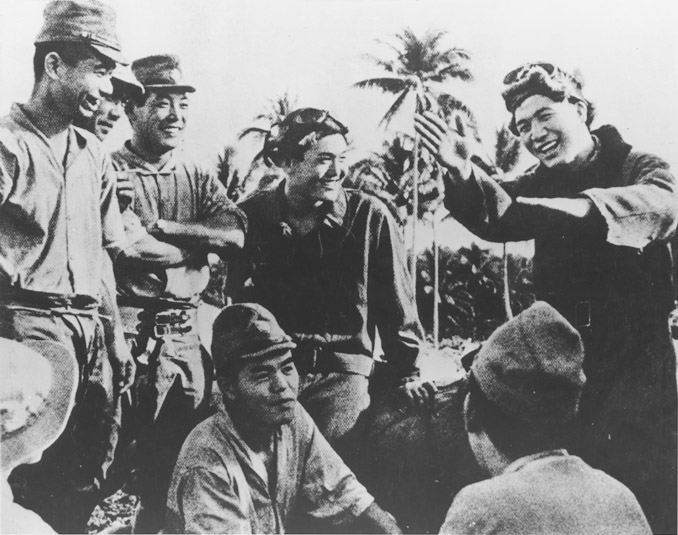
Credits
Produced & Written by William F. Kauffman
Directed by William F. Kauffman & John E. Stewart
Filmed & Edited by John E. Stewart
Narrated by Walter S. Burr
Music Composed by Jose Herring
Dramatic Portrayal by Brian Willems
82 minutes
Clips from the film
In 1941, more than 1,100 civilian men ventured 4,000 miles across the Pacific to desolate Wake Island to build a U.S. Navy base. Just hours after Pearl Harbor was bombed, Wake Island was attacked and these men were thrust into the forefront of the war in the Pacific.
Despite their civilian status, the construction workers pitched in to help the under strength Marine contingent hold off the Japanese attackers. For 16 days, the defenders of Wake Island provided inspiration and hope for an America shocked by the devastation at Pearl Harbor.
This is the story of the civilians of Wake Island. Barely a footnote in the annals of the battle for Wake, their contribution on the guns and on the bulldozers during the battle could not have been more significant. This is the story of why these men were sent there, who they were, what life was like on Wake prior to the war and then when war came what were their experiences.
This film accomplishes this through the use of Marine Corps and civilian survivor interviews, still photos and motion pictures. The photography is from U.S. military archives, rarely seen captured Japanese military film and combat art and even Pan American Airways historical footage. Pan American Airways had a flying boat base on Wake before the war.
At the request of the Wake survivors the film does not go into the time these men spent as POWs. At the time of filming there was a pending lawsuit against the Japanese manufacturers, similar to the ones filed against German corporations
Making of "Those Who Also Served"
The men that history almost forgot
In April of 1942, Paramount Pictures produced “Wake Island” starring William Bendix, Brian Dunleavy and Robert Preston. It was Hollywood’s very first World War II movie.
The film told the story of “ Wake Island,” a Pacific island outpost that was attacked only hours after the bombing of Pearl Harbor. The severely out-manned and out-gunned Marines held out and fought off almost daily bombing raids, and repelled an invasion attempt only to be overwhelmed by a second one after their sixteenth day of battle. The movie was a huge success not just monetarily, but also for the Marine recruiting program.
The idea for a documentary was considered because the actual events of the last days of Wake in the original 1942 movie were based on conjecture, due to the island having surrendered to the Japanese and all of the combatants having been either killed or captured. For over twenty years, I have had a copy of Major James P. S. Devereaux’s book “ Wake Island,” published in 1947, that gives his account of the battle, as the Marine commander on the island. I realized that the original movie did not do the defenders of Wake justice in portraying their sacrifice and heroism.
During my preliminary research I discovered that there had been over 1,000 civilian construction men on the island. These were the men of CONTRACTOR’S PACIFIC NAVAL AIR BASES, civilian construction men, who had volunteered to build a base on Wake. The concept of Navy construction men, SEABEES, did not exist until after the war started. A great number of these civilian construction men had taken part in the defense of Wake Island either by actually handling weapons or by daily building and rebuilding the defenses of the island. Although, I had known civilians had been on the island, I had not known the extent to which these men had played a part in the defense of Wake or that they had been sent to POW camps alongside the military defenders and spent almost four years as prisoners. Being a student of history, a former Naval aviator and Naval Academy graduate I felt I should have known this, but I didn’t. I felt this story needed to be told. The documentary format was selected, so that people could actually see these men –-the men that history almost forgot.
The documentary was over two years in the making. The film covers: why Wake was important, who these men were and why they went there, as well as what they did, not just during the battle, but before as well. It covers the island commander, Navy Commander Winfield Scott Cunningham; the Marines, Major Devereaux, Major Paul Putnam, Captain Wesley Platt, Lt. Poindexter and Lt. John Kinney to name a few. It, of course, presents the head civilian contractor, Nathan “Dan” Teeters, and several of his men such as Walter “Swede” Hokanson and Dr. Shank.
The documentary does not address their prisoner of war experience. This was at the request of the survivors. At the time they had a lawsuit pending against Japanese manufacturers similar to the one filed by those who had been used as slave labor in Nazi Germany.
My travels to meet Marine and civilian survivors took me to Arkansas, Idaho, California and Hawaii. I made several trips to the National Archives in College Park, MD., and to the National Archives Annex in San Bruno, CA. The Department of the Army now supervises Wake Island and the people there readily lent me their assistance to travel and do filming and research on Wake. Curators at the Air Force museum at Pearl Harbor and the Navy SEABEE museum at Port Hueneme, California, were very helpful. Professor Gregory J.W. Urwin, of Temple University and author of “Facing Fearful Odds: the Siege of Wake Island,” was invaluable.
The defenders of Wake Island, both civilian and military were a pleasure to meet. The youngest man I met was 78 and the oldest was 92. They were all gentlemen and it is with deep sadness that I learned two of them passed away before this documentary was finished. Colonel Arthur Poindexter passed away just four weeks after I interviewed him. Civilian Pete Ingham passed away seven months after his interview.
Lastly, this documentary could not have been made without the assistance of John Stewart of Walther/Stewart and Associates. When I decided to tell this story, he readily signed on, bringing his camera and editing system to help make the story come to life.
It has been an honor to tell this story.
William F. Kauffman
Producer “Those Who Also Served”
Filmmakers Bio
 WILLIAM F. KAUFFMAN
WILLIAM F. KAUFFMAN
Producer-Writer-Director
A member of the Screen Actors Guild, William’s roots are as an actor. He initially performed on stage as a pre-teen in Atlanta with the Atlanta Children’s Civic Theater, performing in such classics as “Snow White and the Seven Dwarfs” and “Ali Baba and the Forty Thieves.” He continued on stage during high school as Rabbit in “ Winnie the Pooh.”
Although he had a love of performance, his other love, aircraft, opened an additional career for him. William was awarded an appointment to the U.S. Naval Academy. Following graduation, he earned his wings as a Naval Aviator flying E-2 Hawkeye aircraft from aircraft carriers. While onboard his carrier he co-wrote and performed in shows for his fellow shipmates. After over 7 years of active service, he transferred to the Navy Reserves. He still flies, but has returned to the performing arts.
Returning to Atlanta , he once again performed on-stage. In addition, he was getting cast in commercials and industrials. In 1995 William moved to Los Angeles . He began studying under David LeGrant, a veteran of the 1950’s Actor’s Studio, the era of Marlon Brando and Marilyn Monroe.
In Los Angeles , William has been active in the film, commercial, industrial and live theater arenas. He has appeared in spots for The Fox Family Channel, Comedy Central, DiTech.com, Pontiac, and Honda (Japan), just to name a few. William also had the lead in “The Face in the Frame,” an independent film. In addition, he starred in a series of one-act plays by Michael T. Folie at North Hollywood ’s Raven Playhouse.
At a filmmaking program offered at The American Film Institute, he branched out and co-wrote and co-directed the comedy short “PRT Woman.”
William Kauffman founded Aviator Pictures. He recently completed, “Those Who Also Served,” a documentary that tells the story of a group of civilian construction men on Wake Island, building a US Navy base in the Pacific in 1941. As part of CONTRACTOR’S PACIFIC NAVAL AIR BASES, they were attacked by the Japanese just hours after Pearl Harbor and held out for 16 days before surrendering and then spending four years in Japanese prison camps. The documentary covers the exploits of the island commander, Commander Winfield Scott Cunningham, the Marine Majors James Devereaux and Paul Putnam and the civilian leader Nathan “Dan” Teeters, as well as many of the civilians in their struggle against the Japanese. Upcoming projects include the production of an original dramatic screenplay and an adaptation of a short story.

